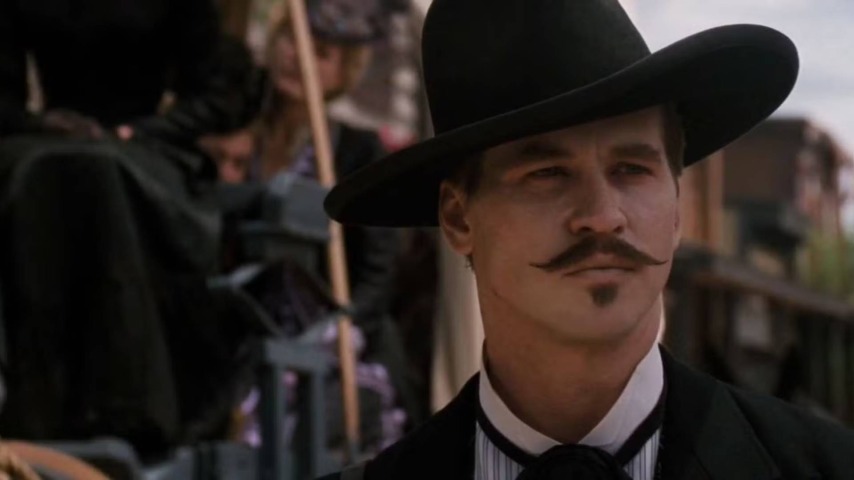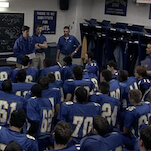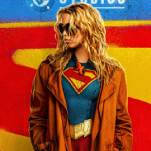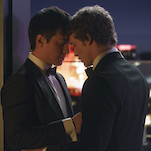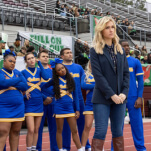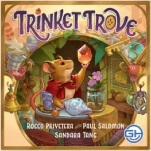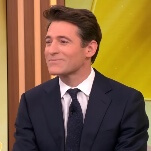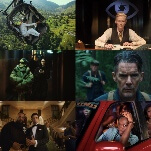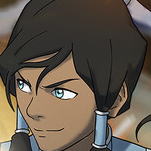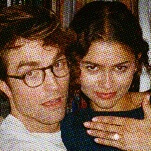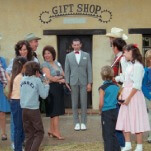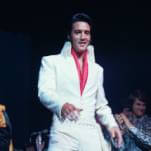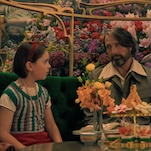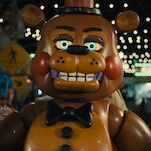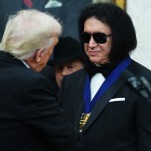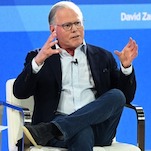Val Kilmer was not a movie star. That’s just what we called him. The late actor definitely starred in a lot of movies. Big movies, the kinds built around big names, sex appeal, and action, which put his name right at the top of the poster. He was Batman, he was Iceman, he was Jim Morrison. Val Kilmer, in his prime, meant box office dollars in a way that said “movie star” to the industry.
But for all his charm, good looks, and million-dollar smiles, Kilmer sought to subvert his own movie star persona, always looking for the most creative way to perform the most straitlaced roles. Even when playing to his largest audiences, with grand budgets and costumes and all the trappings of superstardom, he slapped his expanding belly as Jim Morrison, snapped his teeth at Tom Cruise as Iceman, contrasted Joel Schumacher bombast as an icy Batman. Kilmer was always digging for the unexpected honesty in his characters, no matter how airbrushed and perfect his surface looked on screen.
Beyond his pouty lips and chiseled jaw was a taste for the idiosyncratic; behind his dreamy eyes there was a searcher, eager to brush deliberate subtleties and flaws into the canvases of his characters. It’s what made him such an interesting blockbuster presence to begin with, and one can see it especially well in his latter-day work, including a long run onstage completely disappearing into the life and work of American raconteur Mark Twain.
But virtually all of Val Kilmer’s films showcase this complexity, from the way he flips a switch to become a cartoon character of impossible, bumbling grace in Willow to the hilarious double takes and methodical hand gestures that steal Shane Black’s Kiss Kiss Bang Bang from Robert Downey Jr.. But his powers are most evident, and most effective, in a supporting role alongside Kurt Russell—a movie star who always felt more comfortable than Kilmer in down-the-middle leading man parts—in Tombstone.
Nothing about George P. Cosmatos’ 1993 Western is subtle. It’s not a revisionist Western or an anti-Western, nor is it a deconstruction of a legendary lawman. It’s a movie rich in the mythmaking of the American West, as evidenced by its opening sequence, which begins with silent film-era framing and then explodes into a sequence so vivid and so bold that you can imagine it as a Technicolor, VistaVision presentation from the 1950s. That boldness has made it a basic cable staple that pops even on the smallest of screens, and it extends to the performances, from Russell’s badass Wyatt Earp to Kilmer’s silky smooth Doc Holliday.
Looking at the film in the context of Kilmer’s career, it’s easy to see what attracted him to Doc, a role he played in between massive star vehicles The Doors and Batman Forever. The role afforded him the chance to let Russell be the shining star, while he could play in the shadows. The wardrobe is amazing, he got to do a transformative accent, and he could play with castmates like Russell, Sam Elliott, Bill Paxton, and his foil, Michael Biehn as Johnny Ringo.
More importantly, though, Val Kilmer got to play a guy whose inherent coolness and boundless proficiency at getting out of everything alive masks deep psychological wounds more damaging even than the character’s progressing tuberculosis. Doc’s alcoholism, his disease, and his relationship to death make up the true meat of the character, which Kilmer savors. These are the key factors that make not just Doc Holliday, but Tombstone as a whole, land as an epic Western.
The film introduces Doc Holliday stabbing a man over a poker game, then making off with all the cash in the joint with the help of his paramour Kate (Joanna Pacula) and decamping to Tombstone, where he runs into his old friend Wyatt. There is an immediate, deliberate contrast between the two men—Holliday the gambler, gunfighter, and sometimes outlaw, and Earp the sharp-eyed, cold-blooded lawman—which Kilmer milks through a slinky physicality and expressive eyes dancing with impish delight. Doc seems like he’s always getting away with something, a man who’ll rob a poker game rather than lose it, who’ll pal around with a lawman even as he smirks in the law’s face.
Though Kilmer is clearly supporting Russell’s performance, their arcs overlap. As the pressures and dangers of Tombstone are applied to both men, Wyatt becomes more and more interested in vengeance and extrajudicial might, getting a little more lawless, while Doc leans further into Wyatt’s moral compass, growing more interested in justice than self-preservation. Crucially for Kilmer, Doc’s disease progresses while the stresses of frontier life start to wear him down. It’s here that Tombstone, for all its lack of subtlety, becomes Kilmer’s creative playground, and he finds nuance in the epic.
Doc Holliday has a trickster’s relationship with death, something elevated from subtext to text when he encounters the film’s avatar of Death, Johnny Ringo, and greets him with a drunken “You must be Ringo.” The scene is most famous now for Doc’s response to Ringo’s pistol-twirling theatrics, when he spins his personal whiskey cup to lampoon the empty gesture, but the key to the scene comes seconds earlier.
Doc, drunk and sweaty and hollow-eyed, confronts Ringo as passively as possible, while musing out loud over whether or not he should hate his fellow gunfighter. He jokes, eyes still passive and voice still jovial, “I’m sure of it. I hate him!” Seconds later, he learns that Ringo, like Doc himself, is fluent in Latin. In closeup, still a sweaty drunken mess, Kilmer says, “Apparently Mr. Ringo is an educated man; now I really hate him.” In that moment, still sweat-glazed and staggering, clarity pierces the gunfighter’s eyes. A light goes on, a flame of true hatred and derision, drilled in by the way Kilmer cocks his chin back just slightly, hardens his face, and hammers the point home. It’s much more subtle than the cup-spinning, but it’s worth watching over and over again to see just how clearly Kilmer understood the pain and anger underneath Doc’s façade.
In that moment, Doc’s story begins to weave not just with Wyatt’s, but Ringo’s as well. The broad strokes are simply that Ringo is all bluster and no courage, while Doc is masking tremendous skill and bravery beneath his flippant persona, but when you understand the film’s almost literal attempts to cast Ringo as Death personified (to the point that he quotes the “pale horse” Bible verse in the opening scene), it gets even more interesting.
After their first confrontation, Ringo and Doc meet again on the streets of Tombstone, when Ringo tries to challenge the Earp brothers to a fight and is greeted instead by Doc, who declares “I’m your huckleberry” and attempts to turn Ringo’s rage onto himself. It works, but a drunken Ringo is pulled away before they can consummate the fight, and Doc simply stretches himself out and climbs back into his barber’s chair for a shave. The stretch is important, as so many little physical moments are in Val Kilmer performances, because it’s clear through that movement that he understands how big his performance is, how arch Doc is in the eyes of the viewer. It’s cocky in the same way Doc’s little finger taps on his holstered pistol cocky, and it’s all there to set up an astonishing final turn.
Tombstone is a straightforward film. There are clear good guys and bad guys, a clear conflict rising up, and a clear resolution to that conflict. But those big narrative beats are reserved for Wyatt Earp, not Doc Holliday. That means Kilmer finds his own narrative thread and works it out through his performance. This culminates in his crucial final minutes at Wyatt’s side. After the Cowboys gang claims the life of one of his brothers, Wyatt sets out on a bloody ride of vengeance, taking out every member of the gang he and his compatriots can find. Doc comes along, but his disease has sapped him of his swagger and reduced him to a coughing bag of bones barely holding onto a shotgun.
When “Turkey Creek” Jack Johnson (Buck Taylor) asks him why he’s even bothering to come along rather than staying in bed, Doc says simply that Wyatt is his friend. Johnson says “Hell, I got lots of friends.” Doc replies, “I don’t.”
Doc is saying exactly what he feels, laying out his character arc as the cynic who becomes the good man. But Kilmer delivers the line with tremendous sadness in his eyes, with hardened resolve in his set jaw. He has decided that his dance with death, his tricky “I’m your huckleberry” rapport with the Grim Reaper, has to mean something.
So he goes out in Wyatt’s place to duel Ringo, gets a little of his old steel back just long enough to get off a shot, and against all odds, wins. In that moment, as Ringo is reeling from a shot to the head in his final death throes, the restrained, liquid-cool Doc Holliday is gone, replaced by a crumpling of disappointment and taunting as he declares “You’re no Daisy at all.” Another actor would have played it cooler, kept the calm exterior and made the line into a badass mic drop. But Kilmer knew he was playing a man in his last gun battle, and he was shaken by the realization that not even the most feared gunfighter of his era could beat him.
Among the titanic heroes and Western adventure set pieces of Tombstone, Val Kilmer found the ultimate version of the kind of character he always embraced: An almost preternaturally gifted person whose skill and poise masked not just pain, but longing for some kind of transformative experience. Doc Holliday searched for that experience right up until his last line, and Kilmer—who kept taking acting roles even when he could no longer speak—searched for it right up until his final exit from the screen.
